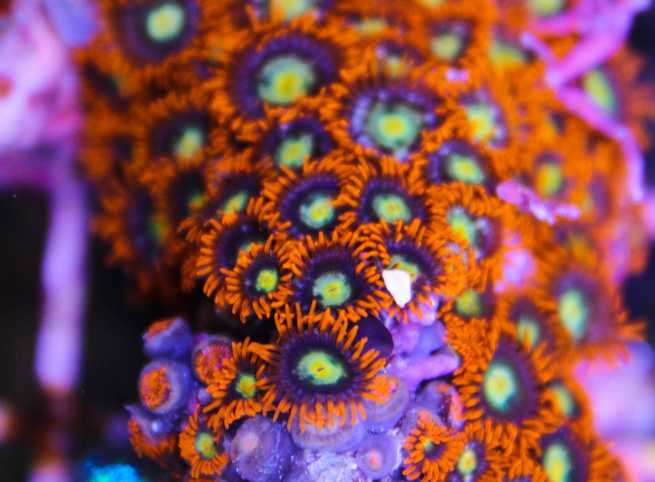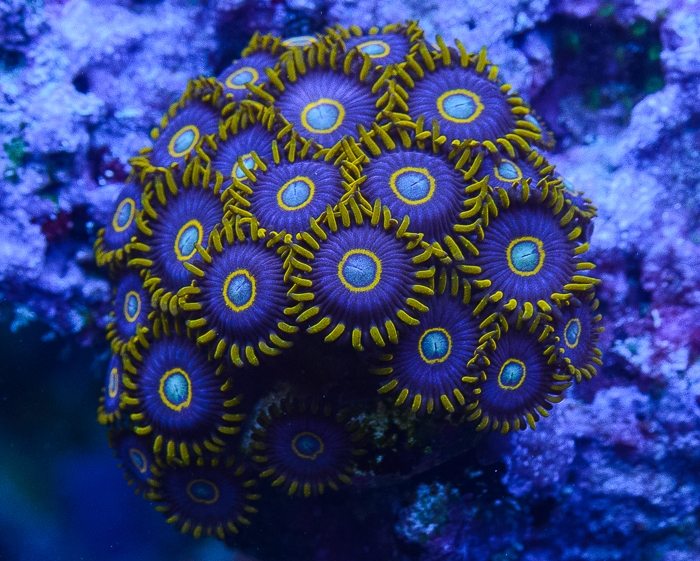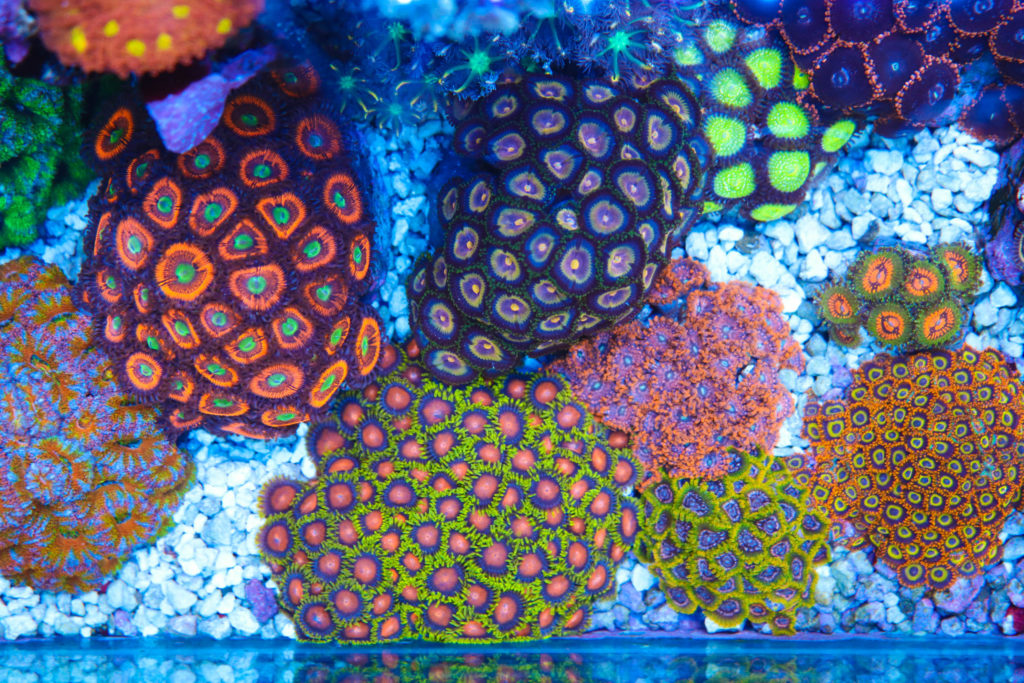The Ultimate Zoanthid Coral Care Guide
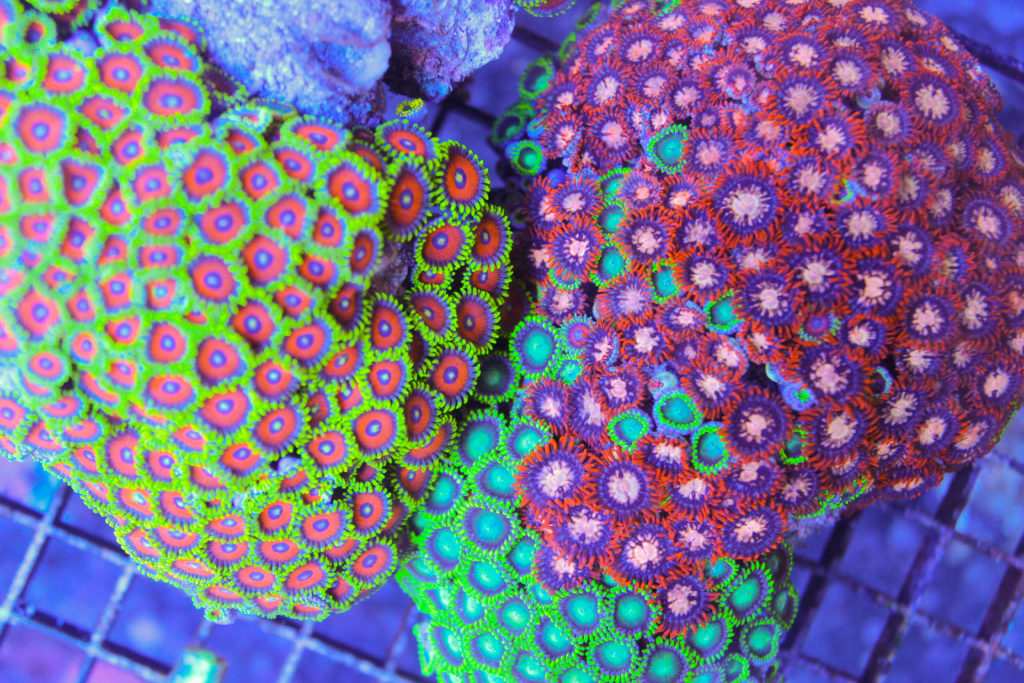 Common Name: Zoas
Common Name: Zoas
Order: Zoantharia
Latin Name: Zoanthid
Class: Anthozoa
Family: Zoanthidae
Origin: Various ocean
Category: Soft
Care Level: Beginner
Temperament: Peaceful
Lighting: Low-High
Waterflow: Low-High
Placement: Low – High
Colors: Various, literally unlimited
Growth Speed: Medium – Fast
What Are Zoanthids?
Zoanthids go by so many different names it can be confusing. We often refer to them as zoos, zoas, zoanthids, palys or even polyps. They are all referring to the same thing, these bright colorful flowerlike corals. They are a colonizing, fast growing beautiful soft species of coral that is arguably the most popular in the reef aquarium hobby. My name is March, I am the owner here at Fragbox and write all of these coral articles and this is going to be the longest, most thorough written article out of any I have ever done because zoas are hand down my favorite coral!
There are so many different fun zoas names to collect and trade
Zoanthids Names
Zoanthids come in almost every color variation imaginable and every year we find new variations. Each variation has a fun trade name, some are classic names that are engrained in the hobby and commonly accepted and recognized by the reef aquarium keeping community. Examples of classic undisputed zoas names are sunny D’s, utter chaos, rastas and blue hornets. These are zoas that are so unique that they are without question that specific strain of zoas. The names are made up by hobbyists or vendors and eventually become accepted by the community as the name based on the lineage. The names are great because they are fun to collect the different varieties, but also it helps hobbyists who are looking to trade or sell. For example if I want to trade you my rastas for your pink hippos we will both understand what we are getting because of the established names. Zoa names can also help collectors identify what they have and not double up certain strains. Different vendors may use different names for different zoas and that’s where it can get confusing (the same name may sometimes go by two different names)
Blue is the rarest and most sought after color for zoanthids
Zoanthids Color & Size
There is literally no limit to the variations and colors zoa can come in. They are all created naturally by mother nature in ocean. They get their color from the zooxanthellae bacteria that lives on them. Usually only the head or mouth has color and most zoas have a purple like body that extend in a colonial matt. Zoanthids can “color up” or down. When they are in their optimal condition they will show off their best colors and under sub optimal conditions the can brown out or lose some of their vibrancy. True blue zoanthids are the rarest color to find in zoas.
There is also an incredible variation in the size of zoas. Some are incredibly small and even called micro zoas, some are jumbo sized, some have very long “frilly” skirts and some have short tentacles. Placement and lighting strength can sometimes dictate the size and color of zoanthids. Under high light they tend to get brighter and shorter, growing closer to their base. Under lower lighting conditions it tens to cause them to swell and stretch towards the light, growing larger head and longer stalks. You don’t want them stretching more than about 1/2” though because this can cause them undue stress and it is signaling they are not getting enough light.
Here you can see campfire palys beside smaller fruit loops zoanthids
Zoanthids vs Paly
They are virtually the same, but we often call larger zoanthdis palys. Palys tend to grow faster and can have some crazy patterns and colors. The real difference is noticeable between zoanthids and true palythoa such as the green death variety or palythoa grandis. This are unmistakably palys and are poisonous which we will get into later.
 Ease of care
Ease of care
Because zoanthids are so adaptable in terms of light, nutrients and flow it makes them one of the easiest corals to care and grow. They are a soft coral and generally soft corals are the easiest of all the coral types. Their body is soft and they don’t require calcium to calcify and skeleton structure like most corals. They do well in clean aquariums ( low nutrients) but are also forgiving of less than ideal nutrient rich waters and will even thrive in ‘dirtier tanks’. They are often thought of as dirty animals. They don’t sting other corals, they are super colorful and grow like weeds. What more could you ask for from a coral ?
Blue hornets like these can sometimes grow slow or grow like nuts
Zoanthid Growth
Zoanthids are simply one of the fastest growing corals in the world. Because of their adaptability and lack of skeleton structure they can grow quickly. Different strains grow at different rates though. Some can grow with explosive speed and are almost invasive and some grow painfully slow. Growth will depend on a lot of factors and they grow at different rates depending on aquariums. For example rasta zoas one of my personal favorites doesn’t grow terribly fast for us in our farm but for some of our customers they grow like nuts. And vice versa we grow utter chaos very well but for some it may grow slow. Its hard to say why or which strains will do best. With time you will find that some zoas just love your aquarium and when they settle in are established will populate at a surprising rate.
 Zoanthid Lighting
Zoanthid Lighting
Zoanthids do well under a variety of lighting conditions and this is part of the reason why they are so easy to keep and grow. They grew like weeds back in the days when hobbyists only had access to Metal Halide options. Under T5 lighting they color up and grow remarkably well. Today the vast majority of reef aquarium keepers are using LED lighting and this is perfect for zoanthids. We currently use radion Leds to illuminate our entire store, coral beds and coral farm which grows literally thousand of zoanthids.
Zoanthids can be accustomed to both high light and low light conditions, they are versatile. We generally recommend placing them lower to the middle part of your aquarium, if they want more or can handle more light they will grow upwards. On the reef they are often found in shallow water under intense lighting growing side by side acropora coral (light demanding species) However, they can bleach and lose color under too much light showing off a pale and stressed appearance. Conversely under too low lighting they brown out and can stretch. 150 Par is the sweet spot for most zoanthids.
 Proper Zoanthid Flow
Proper Zoanthid Flow
Zoas can do well under low but we recommend medium flow. They can tolerate high flow conditions but you want to make sure its indirect and that the heads are still opening. For best results you want moderate, indirect random flow preferably created by a wave maker. The flow helps keep their bodies clean of any detritus build up which can easily accumulate between their heads. Adequate flow also allows them to eat by passing nutrients constantly over their heads so they can catch different foods.
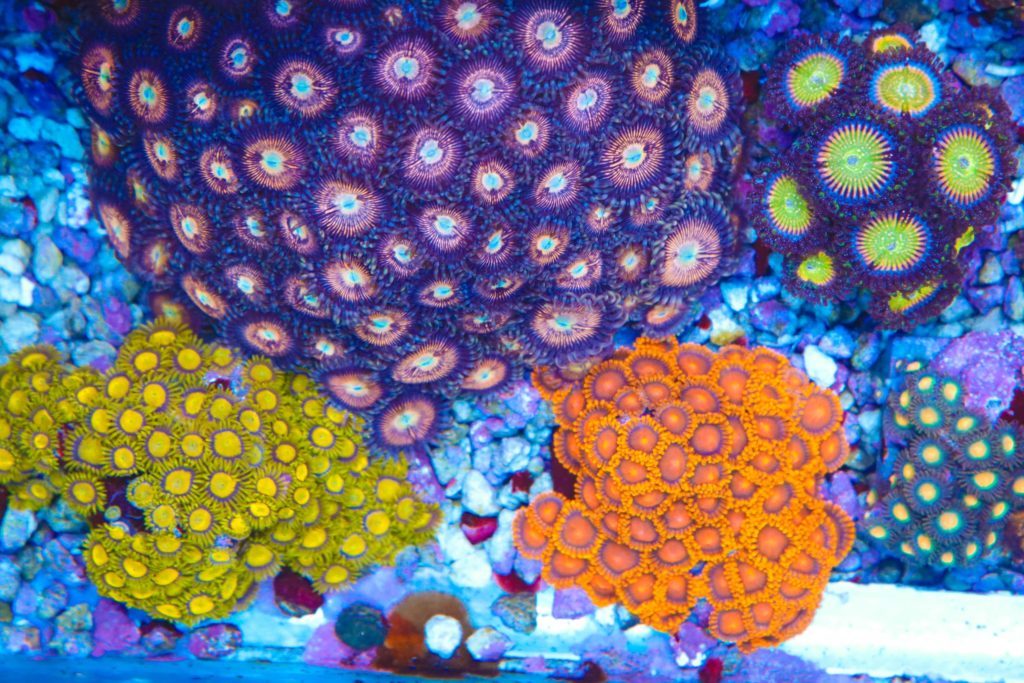
Attaching Zoas To Your Rock
Zoanthids often come on a frag plug, we recommend leaving them on it to avoid damage. If you don’t know how to remove it you can easily damage them, you want to avoid squishing them. You can use reef safe coral glue to attach the plug to your rock, we generally snap off the stem of the plug so you are left with a circular disc that is much easier to glue. You want to plan where you put your zoas because they can be a little tricky to remove from rock once they begin to colonize, they more or less become the rock so plan ahead.
You can find reef safe coral glue here
You can see our video on how to glue coral frags here
A common feature is to group them together forming a zoanthid garden
Zoanthid Gardens
One of the coolest things hobbyists do with zoas in their reef tanks is form zoanthid gardens ! Because they have virtually no sting they won’t hurt each other and they also won’t string other corals. They can be placed directly next to other zoas and corals with no ill effects. Because of this zoa gardens are very popular and people create the most beautiful arrays of zoanthids in their tanks. They are easy to create and just require time to grow out, its fun to pick your different strains and watch them grow and intertwine covering your rock work. Its best to plan out a certain section of your tank to do this in because once zoas begin growing they have no off switch. Place them on rocks that are easily removed or manageable incase you decide to frag or remove later.
Utter

Zoanthid Feeding
Zoanthids are all photosynethic and do not need to be fed to keep and grow them in your aquarium. They however do LOVE to eat and can be fed a variety of different foods. Feeding them increases their color, growth speed and over all health. The larger strains with larger heads will accept meaty foods and will even devour entire frozen brine shrimp. Smaller variations with smaller heads are unable to consume such larger pieces and will rely on smaller particle foods
We feed our zoanthids reef roids
 Water Chemistry
Water Chemistry
We always recommend keeping your aquarium within natural sea water parameters. This means salinity of about 1.026, calcium 450ppm , alkalinity of about 8 , magnesium 1400. Nitrates and phosphates will have the biggest impact on zoas in terms of growth. They seem to prefer dirties water with elevated nitrate and phosphates levels. This is just an observation and we do not recommended increasing these levels as it can lead to nuisance algae and negatively impact other coral health.
Zoanthids need iodine in order to grow, most aquariums replenish iodine through regular water changes. With larger zoanthid collections though aquarium can be iodine deficient and require supplementation. If you notice your zoanthids are not growing with the same speed you may want to consider an iodine supplement as it may have become a limit nutrient in the water.
The most poisonous palythoa grandis, handle with care and respect
Propagation & Toxicity
Zoas are fun and easy to prorogate. SOME strains, not all though contain palytoxin and its impossible to identify which strains those are. Palythoa, paly grandis and palys from the death paly all contain palytoxin, a highly poisonous substance that can harm you if you don’t handle them with care.
Here are some tips for zoa propagation you should always follow.
Always use gloves when fragging
Never squeeze zoas as this can cause them to shoot out toxin in a defense response
Always use safety goggles or glass when fragging
When possible propagate under water
NEVER BOIL ZOANTHIDS (to try to remove from your rock). It causes the palytoxin to go airborne and unknowing hobbyists have hurt them selves this way. It could send you to the hospitale
Never ingest zoas
Frag in a clean work environment away from family, food and other pets
Always wash your frag area and hands after fragging.
Dipping Zoas
Because zoas have 4 known pests its always good practice to dip zoas with coral rx or two little fishies revive coral dip before adding them your aquarium. You really should dip any corals you add to your tank but especially zoanthids.
Check out this video on how to dip corals
Zoanthid Pests
Please see this article that covers zoanthids Pests
Troubleshooting
Please see this video that covers troubleshooting common zoanthid issues

